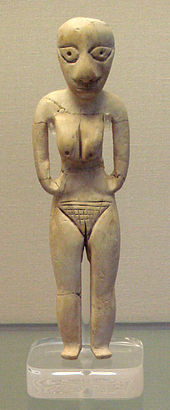Badari culture
The Badari culture was a Neolithic culture in predynastic Upper Egypt . It existed from around 4500 to 4000 BC. Chr. After the end of Merimde culture . The name of this culture comes from the town of the same name, Badari, southeast of Assiut on the east bank of the Nile . Finds in these areas attest to small settlements on the flat desert strip on the edge of the fruitful Nile land. The people living there practiced agriculture, cattle breeding, hunting and fishing.
The Badari graves were first scientifically examined between 1922 and 1931 by the British archaeologists Guy Brunton and Gertrude Caton-Thompson .
The grave cult
At the edge of their villages they buried their dead in oval pits, mostly on the left, in a crouched position and facing west. They were wrapped in mats and given rich additions. While people used rather coarse ceramic vessels in everyday life, they gave their dead fine ceramic dishes made of red or brown polished clay. Typical of the ceramics of the Badari culture was the black edge strip, which was produced using a special firing technique. Another characteristic is a ribbed surface, which they created by “combing” the polish. The additions also include carvings made of ivory and bone. Copper can also be found occasionally in the form of needles and pearls. This distinctive grave cult can be found for the first time in Egyptian culture and also shaped the following epochs.
Copper processing
There is the first evidence of copper and faience working , and cultural ties to Palestine can also be proven.
The end of the Badari culture
From the beginning of the fourth millennium BC The Badari culture merged relatively seamlessly into the Naqada culture , although research has discussed whether the Badari culture was just a local variant of the Naqada culture. The burial rituals were largely adopted.
literature
- G. Brunton, G. Caton-Thompson : The Badarian civilization and predynastic remains near Badari (= British School of Archeology in Egypt Publications. Vol. 46). British School of Archeology in Egypt, London 1928.
- Diane L. Holmes: el-Badari district Predynastic sites. In: Kathryn A. Bard (Ed.): Encyclopedia of the Archeology of Ancient Egypt. Routledge, London 1999, ISBN 0-415-18589-0 , pp. 161-164.
- David Wengrow: The Archeology of Early Egypt. Social transformations in north-east Africa, 10,000 to 2650 BC (= Cambridge world archeology. ). Cambridge University Press, Cambridge 2006, ISBN 0-521-54374-6 , pp. 46-62.
Remarks
- ↑ Michael Brass offers a brief overview . 2002. Badarian government and religious evolution ( Memento of the original from March 4, 2007 in the Internet Archive ) Info: The archive link was automatically inserted and not yet checked. Please check the original and archive link according to the instructions and then remove this notice. , Antiquity of Man.
